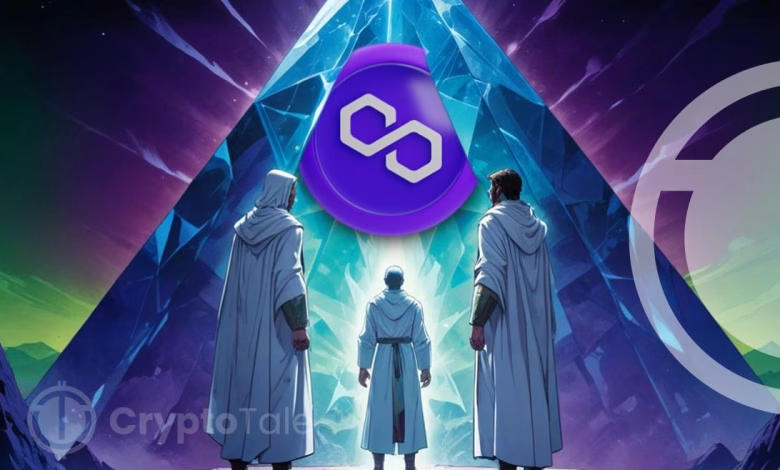A Detailed Review on Polygon Ecosystem

In the fast-moving world of blockchain technology, scalability still remains a major challenge. Polygon’s recent evolution into Polygon 2.0 addresses the issue of scalability along with the liquidity problems. Layers like Staking, Aggregation, Execution, and Proving help developers unlock a new era of decentralized applications. It can be defined by increased efficiency, reduced cost, and error-free cross-chain communications. This article will give you a detailed review of the Solana ecosystem.
What is Polygon?
Polygon is a layer 2 scaling solution for the Ethereum blockchain. The ecosystem consists of multiple chains that host various apps, NFT marketplaces, games, and other projects. It uses a Proof of Stake (PoS) and zkEVM (Zero-knowledge Ethereum Virtual Machine) Rollup to build a scalable and secure application. The platform processes transactions more efficiently and economically than Ethereum, allowing developers to create applications with high throughput and low transaction costs.
History of Polygon
In 2017, Jaynti Kanani, a data scientist, Sandeep Naliwal, a blockchain developer, and Anurag Arjun, a business consultant, created the Matic network (Polygon). The idea to build Polygon came from the NFT project CryptoKitties. Due to the huge popularity of CryptoKitties, network congestion happened on the Ethereum blockchain, which resulted in lower transaction rates with high fees.
The team sold $1.9 billion MATIC in April 2019 to raise funds to develop the project through an IEO on the Binance launchpad. The network was launched in Q2 of 2020 and renamed Polygon in February 2021. Furthermore, during the transition from developing plasma chains to expanding project services, Mihailo Bjelic, a software engineer, joined the team as co-founder.
Since the transition, the network has grown exponentially and has become a top aggregator of Ethereum-compatible blockchains. Polygon 2.0 was introduced in June 2023 and was officially implemented a few months later.
What is Polygon 2.0?
The main vision behind creating Polygon 2.0 is to build the Value Layer of the Internet and provide unlimited scalability and liquidity. It is a protocol that allows anyone to create, exchange, and program value safely without intermediaries. The Value Layer prioritizes users and democratizes access to the global economy.
Polygon 2.0 is a set of proposed upgrades or comprehensive plans that will significantly transform various aspects of the ecosystem, including its tokenomics, protocol architecture, and governance. It consists of multiple layer 2 chains that use zero-knowledge (ZK) technology, which are all interconnected using a new cross-chain coordination protocol. This allows users to have a perfect experience as the network can operate as a single chain. The network is designed to support an unlimited number of chains and cross-chain interactions without requiring additional security measures or trust assumptions.
What Are The Polygon Improvement Proposals (PIPs)?
PIPs describe the technical plans for the initial phase (Phase 0) of creating a network of interconnected Layer 2 chains powered by zero-knowledge technology. The proposals include an outline of how the transition to the new network will occur, specifications for the upgraded token within the Polygon 2.0 architecture, and updates to the native token of the Polygon network.
The PIPs framework allows the Polygon community to provide feedback on the proposed changes and participate in the decision-making process. PIP proposals are,
PIP -18: Polygon 2.0 Phase 0
PIP-18 offers a high-level outline for Phase 0 of the Polygon 2.0 upgrade. The phase is designed in a way that doesn’t require the users and developers on Polygon PoS and Polygon zkEVM chains to take any action. PIP-18 outlines several changes to the Ethereum contracts on the following chains:
- Initiating the upgrade from MATIC to POL.
- Upgrading from MATIC to POL as the native gas token for Polygon PoS.
- Upgrading from MATIC to POL as the staking token for Polygon PoS.
- Launching Staking Layer and migrating Polygon public chains to leverage it.
PIP -17: POL Token
PIP-17 describes POL and the associated contracts for handling emissions and token migration. POL will allow for a one-on-one migration from the current MATIC token, starting with an initial supply of 10 billion tokens and an annual emission of 2%. It will be distributed equally across validator staking rewards and community treasury. This next-generation token will support an ecosystem of ZK-based Layer 2 chains by facilitating staking, community ownership, and governance.
PIP -19: Update Polygon PoS Native Token to POL
PIP-19 proposes upgrading the native gas on Polygon PoS from MATIC to POL while ensuring maximum backward compatibility. This will be achieved by upgrading the native MATIC Bridge Contract and changing the native token on Polygon PoS from a claim on the Bridge’s MATIC to a claim on the Bridge’s POL. This upgrade won’t change any contracts on Polygon PoS, and all the token properties will remain unchanged. The only thing that would be impacted is the contracts on Ethereum expecting MATIC from the native MATIC Bridge.
What Are The Protocol Architectures of Polygon 2.0?
The Polygon 2.0 architecture is a collection of protocol layers that are designed to operate together, where each layer enables a specific sub-process. Polygon 2.0 is comprised of four protocol layers, and they are:
Staking Layer
The Staking Layer is a PoS mechanism-based protocol that is implemented on the Ethereum blockchain. It leverages Polygon’s native POL token to provide decentralization to Polygon’s layer 2 chains through validator pools and a built-in restaking model. This layer consists of two main components,
1. Validator Manager:
It is a smart contract that manages the common validator pool and can be leveraged by Polygon chains to perform operations like,
- Maintains the registry of validators
- Manages staking and unstaking requests
- Enables validators to restake and participate in the validation of multiple Polygon chains.
- Handles slashing events for malicious behavior.
2. Chain Manager:
Chain Manager contracts the validator sets for individual Polygon chains. Each Polygon chain has its own Chain Manager contract, which performs the functions below,
- Defines the required number of validators for each chain.
- Specifies additional requirements for validators, such as compliance or additional staking.
- Optional slashing conditions.
The Staking layer allows validators to stake POL on Ethereum, providing decentralization across the entire exosystem. This ensures that validators are rewarded and motivated to maintain the network’s integrity while enabling chain teams to focus on their specific use cases and community building.
Aggregation Layer (Interop Layer)
The Aggregation layer ensures secure and flawless cross-chain messaging within the Polygon ecosystem. It removes the complexity of cross-chain communication and makes the entire network feel like a single chain to users. This is achieved by facilitating,
- Shared access to native Ethereum assets: Different from traditional cross-chain bridges that require users to mint synthetic version of Ethereum tokens, the Aggregation Layer offers a shared bridge to Ethereum. This allows for perfect cross-chain transfers of native Ethereum assets.
- Seamless flexibility: The layer supports near-instant and atomic cross-chain transactions, which is important for achieving unified liquidity of Polygon 2.0.
Every Polygon chain maintains a local queue of outbound messages (Message Queues), included in ZK proofs that the chain generates. Once a message queue is secured by consensus on Ethereum, any recipient Polygon chain can safely consume its cross-chain messages.
To enhance the cross-chain transactions, the Aggregation Layer introduces a unique component in the middle of Polygon chains and Ethereum, offering key services like,
- Acceptance of ZK proofs and Message Queues from Polygon chains.
- Aggregate ZK proofs into a single ZK proof for Ethereum verification.
Once the ZK proofs are accepted by the Aggregator, recipient chains can accept inbound messages, and knowing ZK proofs ensures global consistency. By aggregating ZK proof, the aggregator reduces Ethereum gas consumption.
Execution Layer
The Execution Layer is where the network executes smart contracts, calculates state transitions, and produces a sequenced batch of blocks. The layer is comprised of several components, and they are:
- P2P: Enable nodes to discover one another and exchange messages.
- Consensus: Enable validators to reach an agreement on a unified view of the chain of blocks.
- Mempool: Collect transactions submitted by users and sync them between validators.
- Database: Stores transaction history
- Witness generator: Generates witness data for the ZK provers.
Proving Layer
The Proving Layer is a flexible, high-performing ZK proving protocol. It is responsible for generating proofs for all transactions for every Polygon chain. This layer is important for efficient cross-chain communication, implementation of ZK state machines, and more. It has components like,
- Common Prover: A Polygon-developed ZK prover is designed to support various transaction types. Using a single prover for proof aggregation and verification makes the process more efficient.
- State Machine Constructor: Developers can use this framework to create their own state machines, which serve as the blockchain’s execution environment.
- State Machine: Polygon offers two state machine implementations, zkEVM and MidenVM.
Polygon’s Adoption of zkEVM Validium
Polygon 2.0 represents a major advancement for the Polygon ecosystem and marks the shift from PoS to zkEVM Validium. The platform’s goal is to upgrade PoS by leveraging the latest ZK technology, aligning it with the vision of Polygon 2.0 without requiring changes from users or developers. While the application functions and fees remain the same, the main differences are the enhanced security for users and seamless interoperability with other chains on the network.
You can think of Validium as a low-cost, high-throughput version of rollup. While Polygon zkEVM Rollup uses Ethereum to publish transaction data and verify proofs, the cost of publishing data to Ethereum is expensive. On the other hand, Validium offers similar security to rollups, but transaction data is available off-chain. The main advantages that Validium has over rollups include:
- Lower fees: It does not consume expensive Ethereum gas to store transaction data.
- Higher scalability: It offers higher scalability than rollups because rollups throughput is limited by the amount of transaction data that can be published to Ethereum.
Related: Polygon (POL) Review: Speed, Efficiency, and Web3 Growth
To Wrap Up
Polygon is a layer 2 scaling solution for the Ethereum blockchain that addresses issues like high fees and slow transactions. Its upgrade to Polygon 2.0 aims to create the “Value Layer” of the internet, enhancing scalability, liquidity, and user experience. The major improvements of Polygon 2.0 includes transition from MATIC to POL tokens, a new staking mechanism, and advanced protocol layers.
For cross-chain interactions, the upgrade includes interconnected layer 2 chains using ZK technology. Its adoption of zkEVM Validium increases security and interoperability while maintaining low costs and high throughput. Polygon’s comprehensive upgrade positions it as an important decentralized application in the blockchain ecosystem.




